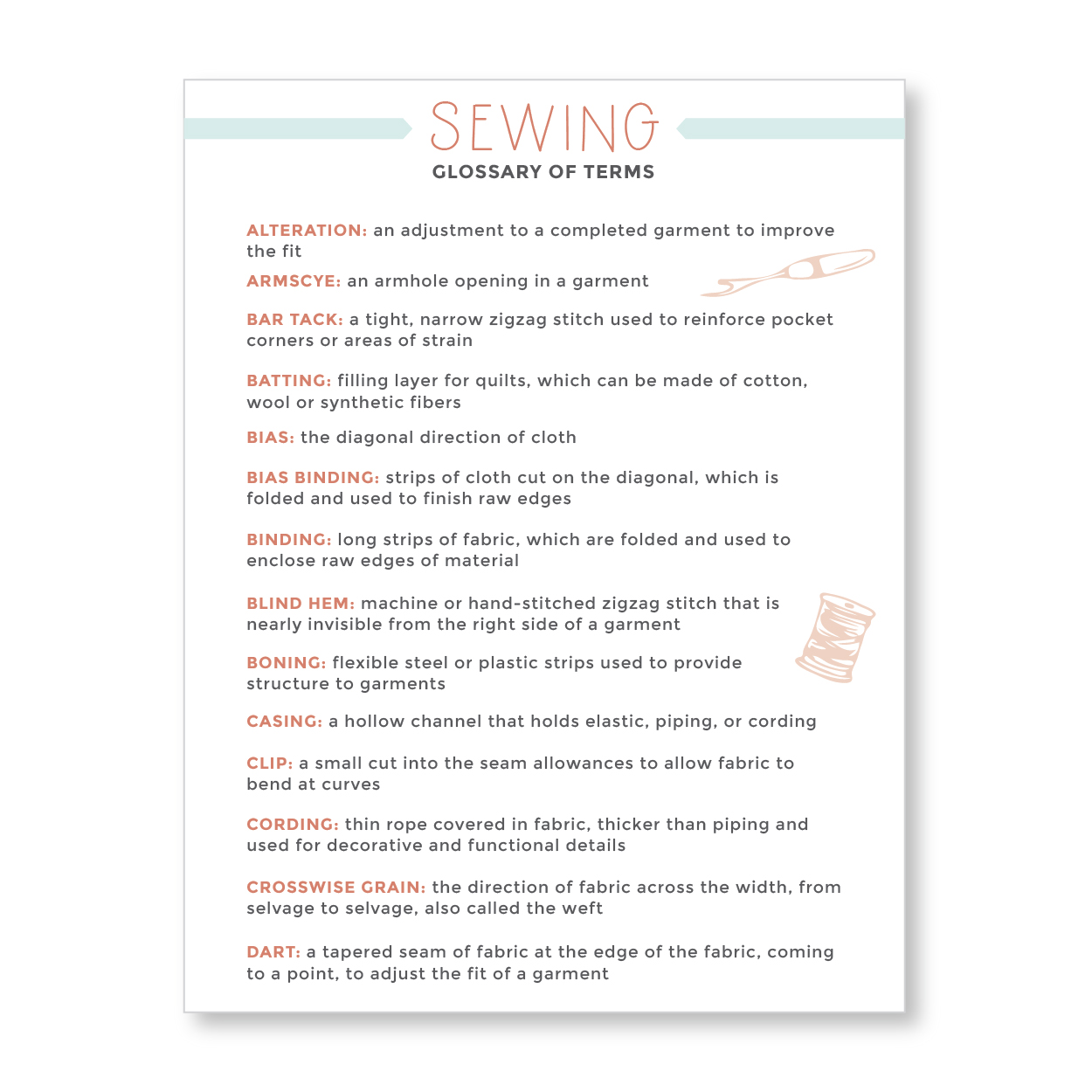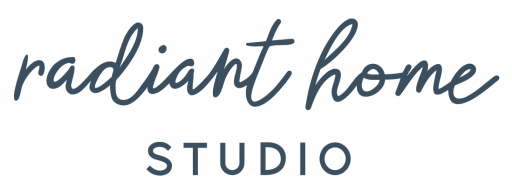I have added a glossary of sewing terms to my resource library to help beginner sewists navigate sewing pattern terminology!
Patterns assume a knowledge of these sewing terms. They are pretty easy to learn, but it helps to have a short glossary of sewing terms nearby to help translate those pattern directions!
Not sure what it means to cut on the bias, pivot, or topstitch? Need a quick description of a French seam? Just download and print this list of sewing terms and their definitions! You can laminate it and keep it close to the sewing machine for reference or use it as a teaching tool for students and children.
Just sign-up for access to the resource library to get the free sewing terms download. In addition to the sewing glossary, you’ll get access to more free downloads & sewing patterns.

If you don’t need the pretty version, or just want a quick definition – keep scrolling!
Sewing Terms:
Alteration:
an adjustment to a completed garment to improve the fit
Armscye:
an armhole opening in a garment
Bar Tack:
a tight, narrow zigzag stitch used to reinforce pocket corners or areas of strain
Batting:
filling layers for quilts, which can be made of cotton, wool, or synthetic fibers
Bias:
the diagonal direction of cloth
Bias Binding:
strips of cloth cut on the diagonal, which is folded and used to enclose raw edges of material
Binding:
long strips of fabric, which are folded and used to enclose raw edges of material
Blind Hem:
machine or hand-stitched zigzag stitch that is nearly invisible from the right side of the garment
Boning:
flexible steel or plastic strips used to provide structure to garments
Casing:
a hollow channel that holds elastic, piping, or cording
Clip:
a small cut into the seam allowances to all the fabric to bend at the curves
Cording:
thin rope covered in fabric, thicker than piping and used for decorative and functional details
Crosswise Grain:
the direction of the fabric across the width, from selvage to selvage, also called the weft
Dart:
the tapered seam of fabric at the edge of the fabric, coming to a point, to adjust the fit of a garment
Directional Fabric:
fabric with a print (arrows all pointing one direction) or with a texture (such as suede or corduroy) going one way
Ease:
the amount of room a garment allows the wearer beyond their body measurements
Facing:
fabric pieces used to finish the inside of a garment or project, usually cut mirror image and smaller than the full lining
Feed Dogs:
thin metal bars with diagonal teeth that pull your fabric through the sewing machine below the needle
Finished Seams:
seams with neatened raw edges, using techniques such as French seams, over-locking, or binding
French Seam:
a seam finishing technique in which fabrics are sewn with wrong sides together first, and then folded over and stitched right sides together with a slightly larger seam allowance, enclosing the raw edges
Gathering:
small folds or puckers in cloth that is created by making two rows of long stitches and pulling the threads
Grading Seams:
trimming seam allowances to different widths to reduce bulk
Grain:
the direction of fibers or weaving in fabric
Grainline:
the vertical line of fibers that runs parallel the selvage edge
Gusset:
fabric inserted into a seam to add breadth or reduce stress, used on both garments and bags
Hand Tack:
a quick, temporary stitch, intended to be removed
Hem:
a finishing method where raw edges are narrowly folded toward the wrong side and sewn in place
Inseam:
the inside seam on a pair of pants, running from the crotch to the end of the pant leg
Interfacing:
a layer of material sewn or fused between the exterior and lining of a garment or bag, used to add structure
Lining:
the inner layer of fabric on a garment or bag, that provides a clean finish and conceals seams
Marking:
transferring symbols from paper patterns to fabric, using tools such as tailor’s chalk, tracing wheels, or disappearing ink pens
Mitered Corner:
a diagonal joining of bias strips at a corner, usually used on quilt borders
Notch:
an arrow-shaped marking on a pattern piece used to match pieces for precise sewing
Notions:
small items used to complete sewing projects, such as buttons, zippers, hooks, thread and pins
Piping:
thin string covered in fabric, used in decorative seams and thinner than cording
Pivot:
when sewing around the corner, leave the sewing needle down in the fabric, lift the presser foot, turn the fabric 90 degrees, lower presser foot and continue stitching the next edge
Placket:
an opening or slit on a garment, usually at the top or front of a shirt or on the shirt sleeves
Press:
using an iron to flatten fabric and set seams by lifting it up and down, not gliding it across the fabric
Pressing Cloth:
a piece of fabric used between the garment and the iron to prevent heat damage to the fabric
Pre-shrink:
washing and drying fabric before sewing to avoid shrinking the final garment
Presser Foot:
the attachment used on sewing machines to hold fabric in place as it is fed through the machine and stitched, with various types (such as a zipper foot) for specialized usage
Rotary Cutter:
a tool with a sharp, round blade used for cutting fabric on a cutting mat
Seam Allowance:
the area between the raw edge of the fabric and the stitching line
Seam Ripper:
a small, sharp tool used to remove unwanted stitches
Selvage:
the tightly woven, finished edge of the fabric that runs parallel to the warp
Shears:
specialized scissors for cutting fabric, usually larger than regular scissors with a slight bend in the handle
Stay Stitch:
a straight stitch in the seam allowance that provides stability and keeps fabric from stretching at the seam
Stitch in the Ditch:
stitching on the outside of a garment or bag, through all layers, in the groove of the seam where it can be hidden
Warp:
the lengthwise grain, parallel to the selvage
Weft:
the crosswise grain, perpendicular to the selvage



